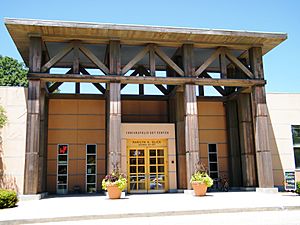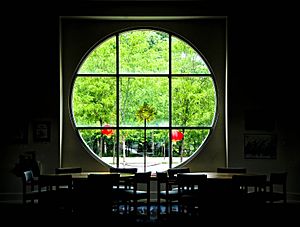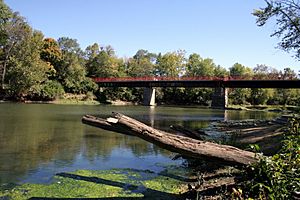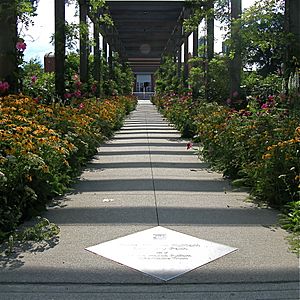Indianapolis Art Center facts for kids
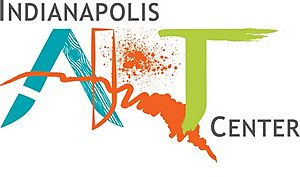 |
|
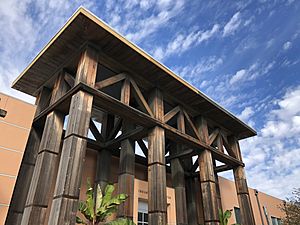
Front entrance of the Indianapolis Art Center in 2019.
|
|
| Established | 1934 |
|---|---|
| Location | Indianapolis, Indiana, United States |
| Type | Art center |
| Visitors | 206,823 (2019) |
The Indianapolis Art Center is a cool place in Indianapolis, Indiana, United States, where you can explore and create art! It was started way back in 1934 during the Great Depression by the Works Project Administration. Back then, it was called the Indianapolis Art League.
You can find it right next to the White River. This center has amazing art shows, fun art classes, and special studios where artists work. It also has a library with over 5,000 books about art and a unique outdoor area called ARTSPARK. In 2008, the Art Center held more than 50 art shows each year and had over 3,000 members who loved art!
Contents
History of the Art Center
The Indianapolis Art League, which later became the Art Center, was started in 1934 by William Kaeser. It was a non-profit group, meaning it didn't aim to make money. This project was part of the Works Progress Administration (WPA), a program by President Franklin D. Roosevelt to help people find jobs during the Great Depression.
William Kaeser was an artist from Austria who studied at the Herron School of Art and Design. He began teaching art to adults, starting with a small group of ten women. By 1938, these groups grew into the Indianapolis Art Students' League. Its name was inspired by the famous Art Students League of New York.
Moving to New Homes
During World War II, it was hard to get gas, so classes moved around Indianapolis. They eventually settled at Public School 66. In the 1950s, the group needed a new place and found a home at the Holliday House in Holliday Park in 1952. This was the first permanent home for the Art League, but sadly, it burned down in 1958.
After the fire, the Art League started raising money for a new building. In 1960, they officially became the Indianapolis Art League Foundation. Many people, companies, and foundations gave money to help. John and Marguerite Fehsenfeld also donated land at 3103 North Pennsylvania St. The Art League built its first new building there, with two art studios and a lobby.
Growing Bigger and Better
About 12 to 15 years later, the League needed even more space. In 1976, they raised $300,000, with big gifts from the Indianapolis Foundation and Lilly Endowment. With director M. Steele Churchman, they built a new 10,200 square foot (948 square meter) building. It was located along the White River in Broad Ripple Village. This new space had five studios, a gallery, a library, and offices.
Within the first year, the number of classes doubled to 40 a week! Because of this success, in 1976, the Art League hired its first full-time leader, Joyce Sommers. She was a former student who had become a board member.
In the early 1980s, the Center tried to run a store, but it didn't work out. Selling the store allowed them to buy more land. The Art League started expanding its buildings in 1989 with the Riverfront Performance Terrace. By 1993, the Art League offered 100 classes a week with 55 part-time teachers.
By 1994, they had raised $7.6 million for a big building project. The new building was finished in 1996. That year, the Art League changed its name to the Indianapolis Art Center because of its huge growth. Joyce Sommers retired in 2009 after 33 years of amazing work. In September 2014, Patrick Flaherty became the new president and executive director.
Amazing Architecture
The Indianapolis Art Center's 40,000 square foot (3,716 square meter) building was designed by Michael Graves, a famous architect from Indiana. Graves was chosen by the Center's leaders because he was a high school classmate of director Joyce Sommers. He had complete freedom to design the building, which cost $6 million at the time.
Money for the building came from many sources, including a large donation from Ruth Lilly, the Lilly Endowment, and other companies and groups. The construction was done by Shiel-Sexton Company from Indianapolis and was finished on time and within budget.
The first part of the building was started in October 1994 and finished in August 1995. It was a stucco building with a 225-seat auditorium, an art gallery, and six art studios. After the original building was taken down, the second part of the project began. It opened on May 31, 1996. The new $8.2 million facility had three art galleries, 13 art studios, a gift shop, and an auditorium. It was four times bigger than the old building!
The building shows Michael Graves's special style. The front entrance has tall 32-foot (9.8 meter) columns. Large rectangular and round windows are placed next to smaller ones. The building's stucco is painted peach, red, and blue. The back of the building has another entrance that looks out over the White River and a sculpture garden.
The two main parts of the building are connected by the Churchman-Fehsenfeld Studio. The west building has the Ruth Lilly Library. This library is an eight-sided, two-story room with 12-foot (3.7 meter) circular windows on all sides. It also has a fireplace with ceramic tiles made in the center's own kiln. The west building also holds the center's offices and studios for painting, drawing, printmaking, photography, and computer graphics. The east side of the building has studios for woodworking, glassblowing, ceramics, metalsmithing, and sculpture.
Michael Graves wanted the building to look like industrial art spaces, similar to renovated buildings in San Francisco or SoHo. The east and west sides of the building have chimneys, one for the library and one for the kiln, which adds to this industrial feel. When the building was finished, Joyce Sommers said, "The new building has given us greater visibility and a much stronger community profile."
Art Education and Classes
The Art Center has always taught art based on Western art history and techniques. Artists like Elmer Taflinger taught at the Art League until 1965. The renovations in the mid-1990s allowed for new art studios and classrooms. There's even an overhead crane to move heavy steel and stone into the sculpture studio!
The glassblowing studio is very special. It made the center one of only nine places in the country where the public can regularly take glassblowing classes. In 2008, the center was working to raise $15 million to improve its glass art program even more.
The Marilyn K. Glick School of Art
The Marilyn K. Glick School of Art is where all the learning happens at the center. They offer classes in many exciting areas, including:
- Glass making
- Woodworking
- Steel fabrication
- Ceramics
- Metalsmithing
- Textiles
- Painting
- Furniture refinishing
- Photography
The center also helps artists find work and has a library with over 5,000 books that anyone can use.
The Art Center offers almost 300 courses each semester. In the fall and spring, over 4,000 students take classes. Summer school is also popular, with more than 1,400 students. The Fine Arts Day Camp teaches children ages 7–12 many creative skills. There's also a Picasso Camp for pre-school children, where they learn about art and music. In 2009, these youth camps had 400 young artists!
In 2010, the Art Center started working with Fall Creek Academy. This gave students access to the campus and classes taught at the center and their school. The Art Center also offers scholarships, chances for continued learning, and even classes for college credit through Marian University.
Art Exhibitions
The Indianapolis Art Center started showing art in 1937. They featured works by artists from Indiana and the Midwest region. They held their first art competition at the Lyman Brothers art gallery. Over the years, they had many exhibitions, like "The Indianapolis Art Students' League Annual Exhibition" and "Art 500." Since 1976, they have held the "Indiana Directions and Regional" show every two years at the Art League galleries.
In its current building, the Art Center has three exhibition spaces. The Main Gallery is in the center of the building, stretching from the entrance to the back. The Art Center also hosts a special show for students. The top five student winners get to show their art during the faculty show!
The center also brings in traveling exhibitions from other places, along with its own curated shows. In 1999, the Art Center hosted "Graham Nash and Nash Editions." This show featured photographs by Graham Nash and related works from his company, Nash Editions. As of 2010, Patrick Flaherty was the exhibition director. He wanted to make art easier for everyone to understand and enjoy.
Special Exhibitions
A Life in Art: Works by George Rickey
In the summer of 2009, the Art Center had a special exhibit about the moving sculptures, models, and sketches of Indiana artist George Rickey. These are called kinetic sculptures. The center also worked with the Arts Council of Indianapolis to show Rickey's art in different places around the city.
Gardens and Outdoor Spaces
The Art Center's grounds are partly wooded and are used for both private and public events. These events include the Indy Jazz Fest, Indiana Microbrewers Festival, Broad Ripple Music Fest, and the Broad Ripple Art Fair. To the west of the main building is the Cultural Complex. The Art Center bought this area in 2003. It is home to the fabric department, the Writer's Center of Indianapolis, and studio spaces.
ARTSPARK: Art Outdoors
The ARTSPARK was created in 2005 and also designed by Michael Graves. It's a 12.5-acre (5.1 hectare) sculpture garden on the Art Center's grounds. It connects to the Monon Trail and has access to the White River. The goal of ARTSPARK is to bring "art, artists, and the community together through multi-sensory sculptures in an open-air setting." It's like a gallery without walls, a place to create art outside.
The ARTSPARK has a special Nina Mason Pulliam Sensory Path, an amphitheater, a riverfront deck, and over 30 public artworks. The idea for ARTSPARK came about in 1996 after Graves's building was finished. Fundraising began in the early 2000s. By 2003, the center had raised $2.6 million, aiming for $5.5 million.
A special groundbreaking for the park happened in June 2005, during the Art Center's 70th birthday celebration. Another groundbreaking took place at the Indiana School for the Blind and Visually Impaired. This celebrated an area of ARTSPARK made for students from the school. It features the artwork Circle created by artist Sadashi Inuzuka and students. The park features artworks by Gary Freeman, Robert Stackhouse, Truman Lowe, Arnaldo Pomodoro, John Spaulding, and others.
How the Art Center is Run
The Indianapolis Art Center is a 501(c)(3) nonprofit organization. This means it's a charity that uses its money to support its mission, not to make a profit. Patrick Flaherty is the director. In 2009, the center had 32 staff members and 616 volunteers who helped out.
A board of 36 people guides the Art Center, led by Board Chair Marnie Maxwell. These board members come from different organizations like Indiana University, Eli Lilly and Company, Fifth Third Bank, IUPUI, and KeyBank. Former chief executive Joyce Sommers is also on the board. The Art Center has nine special funds to help support its work. It's free to enter the Center and its grounds!
Community Outreach Programs
From the 1950s to the 1980s, the Art Center offered outreach programs. They sent volunteers to teach art classes in prisons and for mental health programs. They also worked with the city to create murals at public housing sites, bringing art experiences to 10 housing locations. They also worked with the Indiana School for the Blind and Visually Impaired and St. Vincent New Hope.
ArtReach Program
In 1989, the Art Center started its ArtReach program. This program helps young people who might be at risk. ArtReach gives them two hours of art training each week. They also visit the ARTSPARK to explore the art and grounds. Students get to show their artwork professionally at the center in the Michael Carroll ArtReach Exhibition in the Spring.
Joyce Sommers, a former director, said about the program: "It's not over dramatic to say that art has helped so many kids find a way to find faith in themselves ... when they start making art they are looking inside of themselves and they end up with a product and their self esteem builds. We use the instrument of art for that, besides its intrinsic value."
In 2009, the Art Center started The American Scene program. In its first year, 56 young people aged 5–18 participated. This program encourages young people to make a difference in their community through public art. Students work with a professional artist to choose a location for their artwork. They then work together to create art about Indianapolis. The American Scene program ended with art made by children and people from the Wheeler Mission being shown in the "Beyond Perceptions" exhibition. The SMART program allows 14 young people and their mentors to attend 16 class sessions, three workshops, and field trips in the summer.
Fun Events at the Center
The Art Center hosts many events to raise money. The most famous is the Broad Ripple Art Fair. Major indoor events and talks happen in the Frank M. Basile Auditorium. The Art Center's summer party fundraiser is ArtSparkle. Over 400 people attend, and the money raised helps support the center's educational programs. Film series are also part of the events, shown in the Basile Auditorium. In 2008, the Art Center hosted the Klipsch Chinese Film Festival.
Broad Ripple Art Fair
Every year, over 22,000 people visit the Broad Ripple Art Fair at the Art Center. It started in 1971. The first "art fair" was held in a private home, then on the streets of Broad Ripple. The Art Center directly benefits from the admission fee paid by guests. The festival features over 225 artists and craftspeople from the United States and Canada. It also has live music, fun activities for children, and delicious food.
Day of the Dead Celebration
From 2000 to 2012, the Art Center celebrated the annual Day of the Dead (also known as All Saints Day) on November 1. This celebrated the growing Latino population in Indianapolis. By bringing people from different backgrounds together, the Art Center shared the history, art, and culture of the holiday with the city. There was a big exhibition of altars and shrines, Latino artists showed their work, and there were workshops and a celebration. After hosting the 2011 exhibition, the Indianapolis Art Center passed the celebration to the Indiana State Museum.
See also


